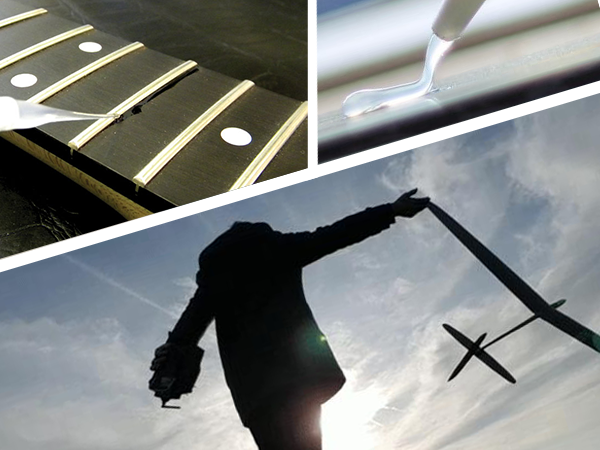Monthly Column July - All about CA
Hi Everybody!
A considerable amount of my time working at The Music Alliance is invested in managing the assortment of luthier tools and materials. While at times this involves pretty complex and specialised products, I also keep an eye on simple yet very useful products and like to use personal experience as an inspiration for choosing new products. For example, I lately added my personally preferred tool (Swann Morton #23 scalpel handle and blades) to TMA’s catalogue. Also, I am very happy to be able to offer professional grade cyanoacrylate glues (aka. Super Glue, Crazy Glue, CA) on short notice.
I am very attached to CA, not because it sticks so almightily well but also I enjoy using it for guitar related repair work and even beyond that. When I am not busy playing or working on guitars I like to fly radio-controlled sailplanes and for building or repairing them CA is very useful. I like to use very runny, water-thin CA as it flows or seeps right into the narrowest gaps before it sets. With some planning and preparation, only a single well-placed small droplet is often enough for a low-weight, invisible and very rigid join.
CA is also useful to keep next to the work bench as a professional luthier. It’s a great help for gluing broken plastic parts like (tuner-)buttons, switch tips and pickguards. CA is well suited for repairing damaged polyester and polyurethane finishes, as it dries very hard and can be sanded wet with sandpaper after it’s fully cured. These properties render CA useful for filling dents and cracks, maybe reseating a separated chip and being able to polishing it to near invisibility. Other uses for CA at the luthier workbench are seating frets while refretting, binding and inlay work or even dropping some CA and bone dust into a slightly too deeply filed nut slot to get a quick but stable fix.
Besides admiration for its practical usability I also respect the at times brute force of CA, that’s why I always use it in a prepared, focused and careful way. I’ve learned the hard way why to respect this stuff! At one time I was building one of my RC planes during the early hours and wanted to use a small drop of water-thin CA to fix the stabiliser to the fuselage. Because the tip of my glue bottle was clogged I figured it a good idea to firmly squeeze it. Well, it wasn’t… the tip not only popped of the glue bottle but the entire content dropped instantly onto the model. I successfully glued the stabiliser directly to my left hand but because the instant release of this much CA caused so much heat and fumes it glued both my eyes shut. I was aware that CA can be dissolved with acetone but I didn’t keep any in my house and wouldn’t be able to use it near my eyes anyway. So, I stumbled to my shower instead and luckily I was able to open my eyes again after half an hour of water and steam. The stabiliser came off of my hand too and eventually even ended up on my plane as planned.
So how to prevent all this mishap? By a rule of thumb I personally NEVER use CA directly from the bottle to prevent the bottle from falling over, dosage issues or clogging the tip. I usually put a few drops in a plastic cup or a sheet of waxed paper and work from there. A piece of steel string with a small kink on its end is usually enough to pick up and carefully place a small drop.
Until next time,
Martijn
Martijn Vink is TMA’s Product Manager Guitar SPA (Strings, Parts and Accessories). He has more than a decade of experience behind the workbench, performing setups and repairs on guitars and basses and communicating with his customers to get the best performance from their instruments. He managed a Dutch guitar store for several years and purchased, restored and traded vintage instruments worldwide. He enjoys playing lead guitar for The Maureens.


















